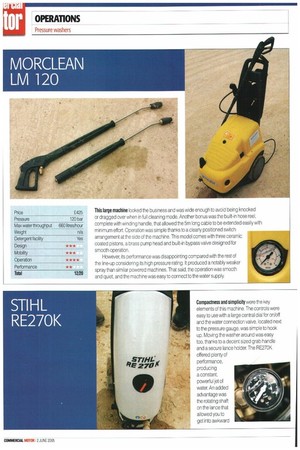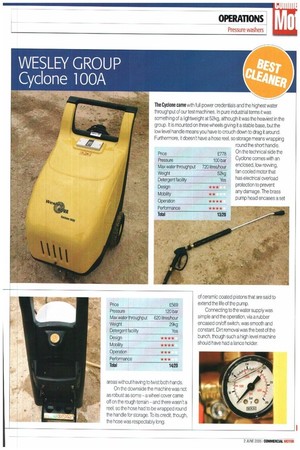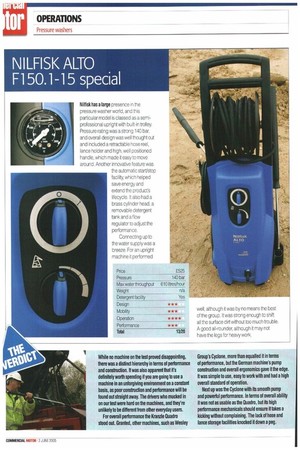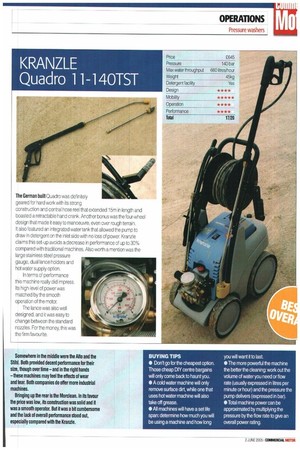UNDER PRESSURE
Page 57

Page 58

Page 59

Page 60

Page 61

If you've noticed an error in this article please click here to report it so we can fix it.
You can't put a price on image — just ask the
CM test team — and that means having a fleet
that's cleaner than the Pope's driving licence. Welcome to the world of pressure washers.
Vchicle cleaning may not be at the top of every operator's "to-do" list, but it's surprising the difference it can make to the way customers and drivers perceive the company. Forget the traditional bucket and sponge method,to get the job done quickly and effectively you'll need a pressure washer.
The world of pressure washers is vast, with a large number of manufacturers producing models that differ greatly in price and performance.There are varying degrees of pressure, water throughput. machine size, features— such as a detergent facility—and portability, as well as hot or cold water machines and electric or petrol power.
The amount of work you intend to do will determine the size of machine you need. Factors to consider include the size of your fleet, how often each vehicle will be cleaned, and the environment in which the washer will be used.A bigger machine may be best for a large fleet that has to be cleaned every day, or works somewhere dirty such as a quarry.
Performance Then there's the question of performance.To gain an understanding of a machine's power. the rule of thumb is to multiply the pressure (expressed in bar) by the water flow rate (expressed in litres per hour) This gives an overall power rating or cleaning rate.
For the CM test we chose five mid-priced machines with a cold water rating. all from well known manufacturers.These ranged in price from £425 to £778 and would be suited for a fleet of approximately 10 vehicles up to 7.5 tonnes.As we don't do anything by halves, the test was conducted in co-ordination with the CM Tipper test at Moreton Cullimore's Cirencester quarry with the quarry providing a continuous supply of filthy vehicles in an environment that's dirtier than a coal miner's overalls Such was the attraction for the regular drivers to have their vehicles cleaned for free it should have been turned into a charity event.
Plenty were willing to take up the cleaning challenge themselves (understandable as the alternative was a mop and bucket) and feedback was duly noted. As most of the pressure washers were relatively small there was initial scepticism, with comments ranging from -that wouldn't take the skin off a custard" to -I've seen more power in my toaster-. But once the machines were up and running everyone was impressed with their abilities. Granted, they did point out that quarry work may be a little taxing for some over time, but all agreed they made life easier. OP. This large machine looked the business and was wide enough to avoid being knocked or dragged over when in full cleaning mode. Another bonus was the built-in hose reel, complete with winding handle, that allowed the 5m long cable to be extended easily with minimum effort. Operation was simple thanks to a clearly positioned switch arrangement at the side of the machine. This model comes with three ceramic coated pistons, a brass pump head and built-in bypass valve designed for smooth operation.
However, its performance was disappointing compared with the rest of the line-up considering its high pressure rating. It produced a notably weaker spray than similar powered machines. That said, the operation was smooth and quiet, and the machine was easy to connect to the water supply.
Compactness and simplicity were the key elements of this machine. The controls were easy to use with a large central dial for on/off and the water connection valve, located next to the pressure gauge, was simple to hook up. Moving the washer around was easy too, thanks to a decent sized grab handle and a secure lance holder. The RE270K offered plenty of performance, producing a constant, powerful jet of water. An added advantage was the rotating shaft on the farce that allowed you to get into awkward areas without having to twist both hands.
On the downside the machine was not as robust as some a wheel cover came oft on the rough terrain and there wasn't a reel. so the hose had to be wrapped round the handle for storage. To its credit, though, the hose was respectably long. The Cyclone came with full power credentials and the highest water throughput of our test machines. In pure industrial terms it was something of a lightweight at 52kg, although it was the heaviest in the group. It is mounted on three wheels giving it a stable base, but the low level handle means you have to crouch down to drag it around. Furthermore, it doesn't have a hose reel, so storage means wrapping round the short handle. On the technical side the Cyclone comes with an enclosed, low rewing, fan cooled motor that has electrical overload protection to prevent any damage. The brass pump head encases a set Price Pressure Max water throughput Weight Detergent facility Design Mobility 2778 100 bar 720 litres/hour 52kg Yes *** of ceramic coated pistons that are said to extend the life of the pump.
Connecting to the water supply was simple and the operation, via a rubber encased on/off switch, was smooth and constant. Dirt removal was the best of the bunch, though such a high level machine should have had a lance holder. Nilfisk has a large presence in the pressure washer world, and this particular model is classed as a semiprofessional upright with built-in trolley. Pressure rating was a strong 140 bar, and overall design was well thought out and included a retractable hose reel, lance holder and high, well positioned handle, which made it easy to move around. Another innovative feature was the automatic start/stop facility, which helped save energy and extend the products lifecycle. It also had a brass cylinder head, a removable detergent tank and a flow regulator to adjust the performance.
Connecting up to the water supply was a breeze. For an upright machine it performed well, although it was by no means the best of the group. It was strong enough to shift all the surface dirt without too much trouble. A good all-rounder, although it may not have the legs for heavy work. The German built Quadra was definitely geared for hard work with its strong construction and central hose reel that extended 15m in length and boasted a retractable hand crank. Another bonus was the four-wheel design that made it easy to manoeuvre, even over rough terrain. It also featured an integrated water tank that allowed the pump to draw in detergent on the inlet side with no loss of power. Kranzle claims this set-up avoids a decrease in performance of up to 30% compared with traditional machines. Also worth a mention was the large stainless steel pressure gauge, dual lance holders and hot water supply option.
In terms of performance this machine really did impress. Its high level of power was matched by the smooth operation of the motor.
The lance was also well designed, and it was easy to change between the standard nozzles. For the money, this was the firm favourite.






































































































































































































